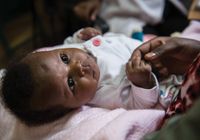Newborn Care Supply Kits, supplied by UNICEFabbreviation, include the medicines, commodities and supplies to support safe births and newborn survival in the immediate postnatal period. The kits includes supplies for both remote and advanced newborn care.
The Newborn Care Supply Kits are complementary to the Inter-agency Reproductive Health Kits in Crisis Situations, which contain only some newborn health items and are managed by UNFPAabbreviation. Other humanitarian health kits include the Midwifery Kit, supplied by UNICEFabbreviation, and the Interagency Emergency Health Kit, managed by WHOabbreviation. (See Essential medicines and medical supply kits under Key Resources at the end of Chapter 3.) As the SRHabbreviation coordinator is responsible for ensuring coordinated procurement of the newborn and reproductive health kits, ensure that the SRHabbreviation coordinator works with the SRHabbreviation working group members to assess supply needs and procure Newborn Care Supply Kits.If needed, please see the Newborn Care Supply Kits for Humanitarian Settings Manual for further information and information on how to procure the kits.

